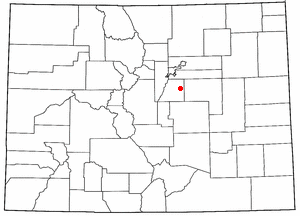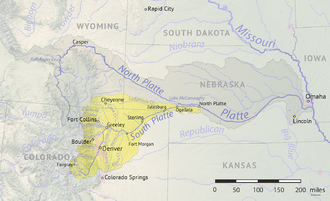Franktown Cave facts for kids
Quick facts for kids |
|
|
Franktown Cave
|
|

Franktown, Douglas County, Colorado Cave
|
|
| Lua error in Module:Location_map at line 420: attempt to index field 'wikibase' (a nil value). | |
| Nearest city | Franktown, Colorado |
|---|---|
| NRHP reference No. | 05001561 |
| Added to NRHP | 2006 |
Franktown Cave is a large rock shelter located about 25 miles south of Denver, Colorado. It sits on the northern edge of the Palmer Divide, a high ridge in central Colorado. This cave is special because it holds many artifacts from ancient cultures.
Prehistoric hunter-gatherers lived in Franktown Cave on and off for about 8,000 years. They started living there around 6400 BC. The site is known for its amazing preserved items. These include tools made of stone and pottery. But it's even more famous for things that usually decay. These are items like animal hides, wood, plant fibers, and corn. People made these goods for comfort, to make tasks easier, and for religious events. Evidence shows people might have used the cave as a camp or home as recently as AD 1725.
Contents
Where is Franktown Cave?
Franktown Cave is a rock shelter located about 198 feet (60 meters) above Willow Creek. Willow Creek flows into Cherry Creek, which then joins the South Platte River in Denver. The cave is more than 6,000 feet (1,829 meters) high.
The cave is on the Palmer Divide. This is a ridge that separates the South Platte River basin from the Arkansas River basin. It's the biggest rock shelter found in this area. The Palmer Divide is an east-west ridge in central Colorado. It runs between Denver and Colorado Springs.
The cave formed when water wore away soft rock layers. This happened below a thick, hard shelf of rock. The area around the cave offered two important materials for making tools:
- Microcrystalline rock: This rock came in white, light yellow, and caramel colors. It formed from petrified wood. Ancient people used it to make projectile points and small hand axes.
- Tuff rhyolite: This material was used for making flake tools.
Near the rock shelter, spring-fed streams flow through the land. The area has scrub oak, open grassland, and ponderosa pine forest.
What Does Franktown Cave Look Like?
Franktown Cave is the largest rock shelter found on the Palmer Divide. The overhang is about 131 feet (40 meters) wide. It measures about 65.6 feet (20 meters) from the front edge to the back wall in its northern part. Most of the digging and artifact discoveries happened here.
The shelter is naturally divided into two parts: a lower shelter and an upper shelter. The upper shelter is on the south side, and the lower shelter is on the north side. Not much digging has happened in the upper shelter. This is because it has thin soil over bedrock and often gets wet. Very few artifacts have been found there.
Ancient Life at Franktown Cave
Scientists divide the ancient history of eastern Colorado into different time periods. These are the Paleo-Indian, Archaic, Ceramic, and Protohistoric phases. People started living in Franktown Cave during the early Archaic period, around 6,400 BC. They continued to live there through all the later periods until about AD 1725.
Archaic Period: Early Settlers
During the Archaic period, people moved with the seasons. They gathered wild plants and hunted animals like deer, antelope, and rabbits. Later in this period, around AD 200-500, people started growing corn. They also began making pottery to store and carry food.
All parts of the Archaic period (early, middle, and late) are seen at Franktown Cave. In the early Archaic period, people were hunter-gatherers. They moved around the mountains and foothills. They hunted smaller animals and gathered more wild plants for food. This was different from their Paleo-Indian ancestors. New stone tools were made to prepare plants for meals.
Scientists believe that large animals like bison antiquus died out. This was due to warmer and drier climate changes about 9,000 to 5,000 years ago. To survive, people hunted smaller game and gathered plants, seeds, and nuts. Franktown Cave is the only well-studied rock shelter on the Palmer Divide with evidence of middle Archaic life. People living in the mountains, like those at Franktown Cave, were slower to adopt new technologies. For example, they were slow to start using the bow and arrow.
Ceramic Period: Pottery and Settlements
The Early Ceramic period, also called the Woodland period, began around AD 0 on the Plains. This time is known for the introduction of pottery wrapped with cords and the bow and arrow. People also started living in small settlements.
At Franktown Cave, Early Ceramic artifacts include pottery pieces and a part of a coiled basket. A small arrow point was also found. This suggests that new technologies were adopted more slowly here than at some other sites.
Artifacts from AD 780-1290, the Middle Ceramic period, include small, unique arrow points, clothing, charcoal, and corn cobs. A net made of animal sinew and twigs was also found. This net is similar to hoops used in games by some Native American groups. Pottery from Franktown Cave shows influences from cultures to the south and northeast.
The number of people and how much they moved changed over time. More sites from the Early Ceramic period suggest a rise in population. But by the Middle Ceramic phase, there were fewer sites. This means people stayed in one place for shorter times and lived in smaller, more mobile groups.
Protohistory: Diverse Cultures
During the Protohistoric period (1540 to 1860), groups of people became more diverse. They were more likely to settle in one or two places. They grew food, raised animals, made pottery and baskets, and performed ceremonies. Artifacts from this time include corn cobs, arrow points, and pottery fragments. It is thought that the people of the Dismal River culture were Apache Native Americans. After a decrease in population during the Middle Ceramic period, the population in eastern Colorado seemed to grow again in the Protohistoric period.
Uncovering the Past: Archaeology
Franktown Cave was a great place to live because it was protected from bad weather. It faced east and was the largest rock shelter found on the Palmer Divide as of 2005. It measured 40 feet (12 meters) wide and 20 feet (6 meters) deep. Large rocks at the front of the cave offered protection. The southern part of the cave was dry, which helped preserve most of the items found. The upper level had water seeps, so fewer artifacts were found there.
Amazing Artifacts Found
More than 4,000 artifacts were found at Franktown Cave in the 1940s and 1950s. These items tell us a lot about the people who lived there. They can be grouped into four main types:
- Chipped stone artifacts: Over 2,180 items, including arrow points and fragments.
- Groundstone artifacts: 234 items.
- Potsherds: 862 pieces of broken pottery, some with cord marks and some plain.
- Perishable artifacts: 351 items that usually decay. These include fibers, animal hides, bones, and wood.
- Ecofacts: 791 items that show evidence of ancient environments. These include corn and other plant remains, animal bones, shells, and wood.
The large number and variety of perishable artifacts and ecofacts found at Franktown Cave are very rare. They are almost unknown from other sites in the Platte River Basin.
Studies of the pottery show that it was made from local clay. The clay was put together in patches, then strengthened using a paddle and anvil. This method was common at other sites on the Plains. Pottery analysis suggests that Franktown Cave was used more often at the end of the Early Ceramic and beginning of the Middle Ceramic periods.
Woven materials found, like sandals, show connections to people in the South and Southwest. Different types of sandals were made for winter and summer. More complex sandals with straps for grass socks were used in cooler months. Lighter sandals were used in warmer months.
Animal hides used for clothing were also found. There were many bison bones and other large animal bones. Rodent bones, snares, and rabbit hide robes suggest that small game was also important. A worn moccasin was found, dating to between AD 980 and 1160.
The stone tools show that people mainly used local materials like petrified wood, rhyolite, and quartzite. This pattern of using local materials is also seen at other sites in the Palmer Divide area.
Corn became important to the people at Franktown Cave during the transition from the Early to Middle Ceramic era. During the Middle Ceramic period, the climate was wetter and milder. The human population in the area was also higher.
Archaeologists have dug at Franktown Cave for over 50 years. The table below shows some of the artifacts found and when they were used.
| Cultural Period | Time Period | Baskets and Ceramics | Clothing | Corn / Plants | Stone Tools | Other Items |
|---|---|---|---|---|---|---|
| Early Archaic 6400-3800 BC |
6400-3800 BC | Projectile points | ||||
| Middle Archaic 3800-1250 BC |
3350-2470 BC | Coiled basket | Sandal, rabbit hide robe |
|||
| Late Archaic AD 1250 - 150 |
AD 130-420 | Charcoal | ||||
| Early Ceramic AD 150-1150 |
AD 660-800 | Coiled basket, early ceramic sherd |
||||
| Middle Ceramic AD 1150-1540 |
AD 720-1290 | Middle ceramic sherd, plain bowl sherd |
Legging, moccasin | Corn cob | Charcoal, Sinew/twig net |
|
| Protohistoric AD 1540-1860 |
AD 1280-1950 | Corn cob, corn kernel | Dismal River sherd |
Franktown Cave is similar to other important sites like Trinchera Cave and Chamber Cave. These sites also show strong evidence of people living there for long periods. They also have many preserved items. These other sites are south of Franktown Cave and were influenced by people from the southern Great Plains.
Who Dug Here?
Many people have studied Franktown Cave over the years.
| Date | Name | What They Did |
|---|---|---|
| 1942 | Hugh Capps | The first professional excavation. He donated 208 items to the University of Denver. |
| 1949, 1952 | Professor Arnold Withers | Excavated and created maps of the cave's inside. He found 1,779 items. |
| 1956-57 | Gerold Thompson | Excavated 1,292 items and combined them with earlier findings. He started a report but couldn't finish it. |
| 1976 | Dr. Sarah Nelson | Investigated the site for one day. She collected about 570 remaining items and took photos. |
| 2003 | National Science Foundation | Funded analysis and dating of perishable items found at the site. |
Hugh O. Capp, Jr. was the first to dig at Franktown Cave in 1942. He worked on the north side of the cave. Later, Arnold Withers dug there in 1949 and 1952. Gerold "Tommy" Thompson excavated in 1956 and 1957. He found a sandal and cordage. Thompson figured out there were at least two types of sandals: winter sandals with complex straps and grass socks, and summer sandals with simpler straps.
In 1973, Charles W. Manz studied stone tool waste from the cave. He found that people at Franktown Cave mostly used simple tools made from local materials. Sarah M. Nelson and Sarah Studenmund studied the pottery. They found that all the pottery from Franktown Cave was very similar, whether it had cord marks or not.
Before the 1940s, local Boy Scouts also explored the cave. Sadly, the site has also been looted over time.
Why is Franktown Cave Important?
Franktown Cave was added to the National Register of Historic Places in 2006. This means it is recognized as a very important historical site.
See also
 In Spanish: Franktown Cave para niños
In Spanish: Franktown Cave para niños



